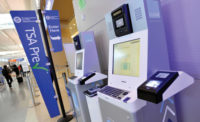Fast. Touch-free. Frictionless. In-motion. Easy to install. These are all adjectives that many end users couldn’t have imagined associated with reliable biometric technology a decade ago, never mind a couple of years ago. Yet, these are the latest trends across all authentication technologies, from fingerprint to facial to iris recognition, experts say.
These new evolutions are paving the way for broader adoption of biometric technology in new vertical markets. Some of these biometric technology trends have been born out of a customer focus on aesthetics and convenience.
“Design has become extremely important,” says Shiraz Kapadia, CEO and president of Invixium, Toronto. For many of these systems, advancements in design translate to unobtrusive profiles, LCD and color displays, backlit keypads, and the ability to blend into an environment as completely as possible.
“Customers want minimal inconvenience, both to users as well as to the environment. For example, they don’t want to spend hundreds of millions of dollars building a high-end facility and be forced to install very bright or harsh lighting to facilitate authentication, or to have to tell people they have to position their body a certain way or stand still for too long. These are not acceptable to the average customer of today,” says Gary Jones, vice president of IDEMIA (formerly OT-Morpho), headquartered in Billerica, Mass.
According to Larry Reed, CEO of ZKTeco USA, Fairfield, N.J., advancements in aesthetics and convenience have led to further adoption of biometrics in relatively new markets, including high-end residential and membership businesses, such as health clubs, golf clubs and tanning salons.
“With a traditional ID card, there is a tremendous opportunity loss for these businesses if people are just sharing or lending their cards to one another,” Reed says. “On the residential side, people are installing biometrics for gates, wine cellars, garages, even closets.” Reed adds that building complexes in major cities are installing biometrics at doors, coupled with video surveillance, as a non-invasive way to crack down on illegal subletting.
Convenience
Convenience is a trend that some say has been pushed by a new generation of employees, managers and executives that grew up with technology at their fingertips and, in turn, expect tight security with a minimal level of interaction. Take Princeton Identity’s IOM Portal100, a multimodal system for both iris and face recognition, that doesn’t require the eyes or face to be inches from the camera, while authenticating 20 people per minute; or IDEMIA’s frictionless MorphoWave technology, an in-motion, touchless biometric system, which scans four fingers in three dimensions at a rate of more than 45 people per minute; or Invixium’s multimodal TITAN, which can authenticate 15 faces per minute and can be installed from start to finish, including enrolling 10 people, in 19 minutes.
“I do believe that on-the-move, contactless or frictionless biometrics is certainly where we are headed, regardless of the authentication technology. The industry wants to identify people on the move, without that contact,” emphasizes Mark Clifton, CEO of Princeton Identity, Hamilton, N.J.
Part of the convenience trend is open-platform, easier-to-install, IT-ready biometric authentication systems. The barriers of incompatibility or difficult installations of early biometric systems have dramatically dwindled. “In the past, these devices didn’t have Ethernet ports, for example. They needed a separate power supply and had to install client and server applications separately. It was all too much,” explains Kapadia of Invixium. “Now, the software is Web-based, the devices are Bluetooth-ready and Wi-Fi-enabled, and they have all the connectivity options needed.”
Multimodal Biometrics
Integrators wanting to meet their customer needs of convenience and security have pushed the industry toward multifactor authentication, which is another trend that has taken flight within the last few years.
“We are definitely seeing this trend of multimodal authentication happening quite a bit,” Clifton says. “I always tell people, ‘We can do the face for free.’ We are already capturing iris, for example, and to do that we have to find the face and find the eyes so we might as well use the facial recognition, too. It also really raises the bar with someone’s security.”
And raising the bar of security is most certainly something customers are expecting with biometric systems, say those in the industry.
“The challenge here is the compromise between security and convenience. In technology, you don’t often see the kind of change we have seen with [biometrics] the last few years,” says Jones of IDEMIA. “There is a real push for frictionless solutions with different [authentication] technologies, which maximize throughput without compromising the security. There have been big technological breakthroughs in imaging and processing, resulting in much higher accuracy and much more convenience. This is where the industry is going.” n
Biometric Applications in Schools
“The school market is a huge potential market, but the key is to find a way to implement these technologies and still make children feel comfortable and welcome,” says Arie Melamed, head of access control identification solutions at FST Biometrics, New York.
Here are the most popular applications in the school market right now, according to experts:
Athletic Facilities
“We do a lot of business with universities and their athletic departments. A common problem is when students go into these facilities or from the locker rooms to the field, they don’t want to carry anything like keys or access cards. Many were using PIN pads, which were insecure, and in order to stop thefts arising from fraudulent access, biometrics is a more secure and convenient way to handle this,” shares Gary Jones, vice president of IDEMIA (formerly OT-Morpho), Billerica, Mass.
Attendance
“We’ve seen applications where teachers use a handheld biometric device to take attendance. It gets passed around while the professor starts the class, rather than wasting the first 10 or 15 minutes taking attendance manually,” explains Shiraz Kapadia, CEO and president of Invixium, Toronto. “It is used for tests as well, saving time and eliminating fraud.”
Cafeteria Management
“Biometric authentication levels the playing field for those public school students that have free or reduced lunches through the USDA National School Lunch Program,” says Mitch Johns, president and CEO of integrator company Food Service Solutions, Newry, Pa.
Without biometrics or another form of authentication, children eligible for free lunches in the K to 12 sector are often given tickets to identify themselves or put into a separate line from their peers. “Students risk ridicule and embarrassment for receiving subsidized lunches. Now, biometrically controlled cafeterias allow the students to pay for lunches exactly the same way, while securing government reimbursement for the school,” says Larry Reed, CEO of ZKTeco USA.
Johns says that some schools have tried PIN codes or cards for the same purposes, but expecting a young child to hold onto a card or remember a PIN without sharing it with others is not as ideal. “And if the enrollment piece is done correctly, then it’s the faster way to authenticate, too,” he adds.
Visitor Management
“Especially in the [early elementary market], we have many customers using biometrics for pick up and drop off, as well as access control into the rest of the school, classrooms and exterior doors. The technology is getting more and more refined, and it’s less evasive and more passive. It’s a better user experience for everyone,” shares Scott Bohm, president of integrator company Bio Touch Solutions, Clark, N.J.
Melamed of FST Biometrics adds that mobile biometrics on handheld devices are a simple solution gaining increasing popularity in elementary facilities, such as kindergartens, allowing individual teachers to manage dismissals.



